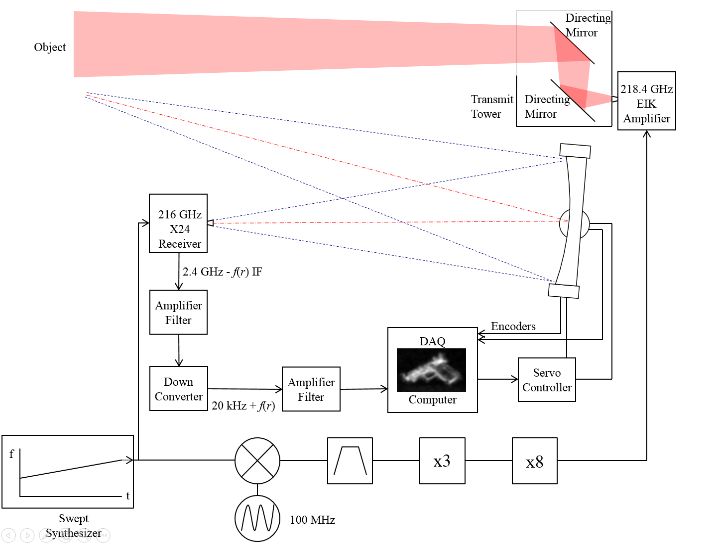Methods for Reduction of Coherent Speckle
If a target is simultaneously illuminated by two or more modes that are phase coherent with one another, no speckle reduction is obtained, but simply a different speckle pattern [1].and Range Resolved Mode Mixing (RRMM) [5]. In the former many modes are illuminated sequentially via a rotating mirror and in the later different ranges (and thus different modes) are illuminated sequentially via a swept frequency cw system. In both cases the sequential mode illumination is fast in comparison to the pixel dwell time.
Figure: TRMMM Experimental Configuration shows a diagram of the experimental configuration. In the RRMM operational mode this system, which is closely related to an FMCW radar a synchronously swept, continuous wave (CW) transmitter and receiver provided range resolution. The synthesizer generated a signal with a center frequency of 9.0 GHz that swept over a bandwidth of 20 MHz (480 MHz after multiplication) in 10 ms. The bandwidth was limited by the final amplifier in the transmitter and the sweep time was limited by the synthesizer. The 9 GHz synthesizer drove the heterodyne receiver and, after a 100 MHz offset is introduced, the signal also drove the transmitter (after a frequency multiplication of x3) to provide a transmit frequency centered on 218.4 GHz. The 5 W EIK amplifier was not needed for this experiment, but was included in preparation for an experiment in a much larger volume.

In TRMMM the frequency sweep was turned off and the mechanical mode mixing mirror activated.The transmitter was a x8 solid-state frequency multiplier with an output power of 30 mW at 218.4 GHz, which drove a 5 W EIK amplifier. The output horn from the EIK amplifier fed into a 24” x 18” x 56” aluminum enclosure. Two directing mirrors steered the beam within the enclosure. A 0.6 m spherical collecting mirror with a focal length of 1 m focused the received radiation onto a single pixel heterodyne receiver with a local oscillator centered at 216.0 GHz. The resulting IF signal had a frequency of 2.4 GHz, and for TRMM, minus a frequency proportional to range.
References
- Speckle Phenomena in Optics: Theory and Applications (Roberts and Company, 2007). Google Scholar
- Multimode illumination in the terahertz for elimination of target orientation requirements and minimization of coherent effects in active imaging systems Opt. Eng. (Bellingham, WA, U. S.) 51, 091604-1,7 (2012). Google Scholar
- Elimination of Speckle and Target Orientation Requirements in Millimeter-wave Active Imaging by Modulated Multimode Mixing Illumination J. Opt. Soc. Am. A 29, 2643-2656 (2012). Google Scholar